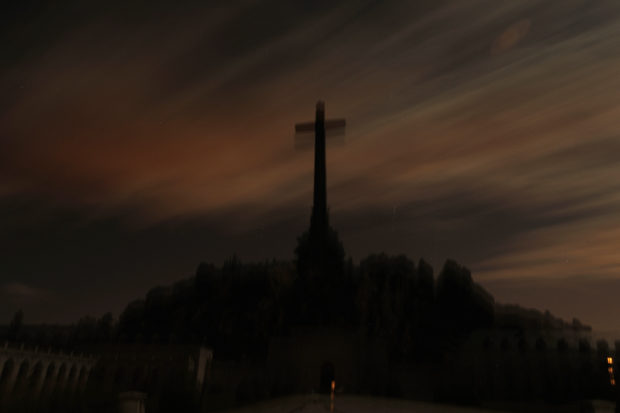
In this photo taken on Monday, October 14, 2019, Guardia Civil officers stand guard in front of the Valley of the Fallen mausoleum near El Escorial, outskirts of Madrid, After a tortuous judicial and public relations battle, Spain’s Socialist government has announced that Gen. Francisco Franco’s embalmed body will be relocated from a controversial shrine to a small public cemetery where the former dictator’s remains will lie along with his deceased wife. (AP Photo/Manu Fernandez)
MADRID — The body of dictator Gen. Francisco Franco is being exhumed Thursday from the grandiose mausoleum at the Valley of the Fallen before being transferred to a more discreet, private resting place.
The much-criticized operation fulfills a decades-old desire of many in Spain who considered Franco’s mausoleum an affront to his victims and to Spain’s standing as a modern democratic state.
The exhumation and reburial will not put an end to Franco’s legacy on the contemporary Spanish political scene, particularly as it comes just weeks ahead of a November 10 general election that is certain to see Spain’s main parties of the left and right battling it out once again.
Who was Franco?
Franco ruled Spain between 1939 and 1975, after he and other officers led a military insurrection against the Spanish democratic government in 1936, a move that started a three-year civil war. A staunch Catholic, he viewed the war and ensuing dictatorship as something of a religious crusade against anarchist, leftist and secular tendencies in Spain. His authoritarian rule, along with a profoundly conservative Catholic Church, ensured that Spain remained virtually isolated from political, industrial and cultural developments in Europe for nearly four decades.
The country returned to democracy three years after his death but his legacy and his place in Spanish political history still sparks rancor and passion.
For many years, thousands of people commemorated the anniversary of his November 20, 1975 death in Madrid’s central Plaza de Oriente esplanade and at the Valley of the Fallen mausoleum. And although the dictator’s popularity has waned immensely, the exhumation has been criticized by Franco’s relatives, Spain’s three main right-wing parties, and some members of the Catholic Church for opening old political wounds.
Why now?
The procedure was finally authorized by the Supreme Court in September when it dismissed a months-long legal bid by Franco’s family to stop it.
The exhumation stemmed from amendments of a 2007 Historical Memory Law that aimed to seek redress for the estimated 100,000 victims of the civil war and the Franco era who are buried in unmarked graves, including thousands at the Valley of the Fallen. The legislation prohibited having Franco’s remains in a public place that exalted him as a political figure.
Having been unable to press ahead with the move last year, Spain’s interim Socialist government of Prime Minister Pedro Sánchez wants the exhumation and reburial completed by next month’s election, a move opposition parties said smacked of electioneering.
Who can attend?
While the Spanish and international press along with many others were keen to attend the exhumation, the Spanish government insisted it would be a private affair. The plan is for 22 family members, including Franco*s seven grandchildren, to be allowed inside the mausoleum but just two will witness the exhumation along with Spanish Justice Minister Dolores Delgado and a handful of officials.
Relatives will then carry the coffin with Franco’s body through the mausoleum for some 300 meters before exiting onto a square where the cameras of Spain’s national television channel will broadcast its placing in a hearse that will bring it to one of two waiting helicopters. If weather conditions do not permit safe flying, the hearse will continue the journey by road under heavy security.
Once at the Mingorrubio cemetery, there will be a private service held at the family crypt, conducted by two priests chosen by Franco’s descendants. One of them is Antonio Tejero, the son of a Spanish Civil Guard colonel who attempted a coup d’état in 1981.
The media will be able to gather outside, where Franco supporters have called for protests.
Next to his wife
Franco’s relatives wanted to rebury him in Madrid’s city-center Almudena Cathedral, where they have a grave slot. But the government, fearing it could become another pilgrimage site for fascists, insisted that he be taken to the Mingorrubio cemetery where his wife, Carmen, is buried in a family crypt. The cemetery is close to the El Pardo palace, once Franco’s official residence.
The Mingorrubio site, much more modest than the Valley of the Fallen whose granite cross can be seen from miles around, is also the burial site for other rightwing figures, such as Dominican Republic dictator Rafael Trujillo and several ministers from the Franco regime.
Political impact
In normal times, the exhumation of Franco’s remains would almost certainly boost the Socialist party’s ratings, especially in the run-up to a general election. But the operation coincided with developments in a secessionist conflict in the northeastern region of Catalonia, which saw the sentencing of 12 former politicians and activists that sparked a week of protests and riots in Barcelona, Spain’s second city and the Catalan capital.
Sánchez has been accused of going too easy on the pro-independence movement to curry parliamentary support. Both the Catalan issue and the Franco exhumation have breathed fresh life into Spanish nationalism and potentially right-wing parties at the election. /kga